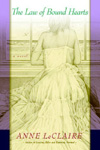




 |
 |
Sister Angst
Exploring the sibling dynamic
by Jeanne McDonald
For women, especially, there is something compelling about stories concerning the intricate relationships between sisters. In such complicated connections, love almost always survives small misunderstandings, but when the offense is seemingly too grave to forgive, an endless void fills the place where that affection once existed.
Anne LeClaire is a writer who has explored the various kinships of women in previous novels, Entering Normal and Leaving Eden. In her newest book The Law of Bound Hearts (Ballantine Books, $23.95) sisters Libby and Samantha (Sam) Lewis, inseparable as girls, part ways in adulthood when Libby betrays Sam so terribly that the link seems irrevocably broken. Each of the sisters struggles with the separation, but each refuses to give in to her better instincts—Libby afraid that any apology will be rebuffed, Sam still nursing the wound that  Libby’s betrayal has caused. Their emptiness is reminiscent of the feeling they experienced as children when they pretended to be Chang and Eng, the famous Siamese twins who were fused at the chest. At bedtime, when Libby and Sam untied the scarves that had bound them together all day, they felt an inexorable sense of loss. Libby’s betrayal has caused. Their emptiness is reminiscent of the feeling they experienced as children when they pretended to be Chang and Eng, the famous Siamese twins who were fused at the chest. At bedtime, when Libby and Sam untied the scarves that had bound them together all day, they felt an inexorable sense of loss.
The Law of Bound Hearts says that when two siblings are connected as one and then are separated, only one will survive. For Libby, survival becomes not only an emotional battle, but a physical one as well when she learns that she has a rare kidney disorder–FSGS (focal sclerosing glomerulonephritis). An organ donor is Libby’s only hope for survival, but when her doctor asks if there is a family member who might be compatible, Libby doesn’t mention Sam, not daring to confront her sister with such a monumental request.
In the meantime, Sam, divorced and struggling to start a new business as a pastry chef, has met Lee, a boatbuilder, who becomes an important factor in the plot development, and not just for Sam, but for Libby as well. At last, her life seems perfect, and she wants nothing to interfere with it, so when she learns of Libby’s illness, she faces a great moral dilemma.
LeClaire says that her idea for the plot came from a newspaper story in the New York Times. “It was about two sisters...,” she says, “one of whom gave the other a kidney. When I saw that article and the photograph of the sisters, I thought, ‘What if two sisters were estranged and one of them needed a kidney?’ Within minutes I knew this was something I wanted to write about, and I was off and running. All the elements of good story were there. Family relationships, the prospect of our mortality, our relationship with our physical body, forgiveness.”
When Libby begins dialysis, the author takes us step by step through her treatment program. The thoroughness with which LeClaire recounts the process sometimes seems a little excessive, yet she clearly records the pain and helplessness of dialysis patients to those of us who are lucky enough not to have first-hand experience. Libby, sick and afraid of what the future holds, alternates between feeling annoyed that her husband, Richard, is too solicitous and, on the other extreme, suspecting that he might be having an affair. And now Sam, whose life has been falling into place with the perfect man and a thriving business, has to decide whether to give up a kidney to save the life of a sister who has committed the ultimate sin against her.
Libby is the more complicated of the two main characters, not only because of her illness, but because of her metamorphosis from the person she was as a child. Her evolution seems a little too extreme when we consider her youthful rebelliousness, disobedience, and disrespect for all the things she later comes to represent. Marriage to Richard, a music professor, morphs her into the perfect wife, perfect mother, and perfect “hockey stick,” a nickname her son’s friends applied to their slim, trim (and perhaps, wooden) mothers.
The tallgrass prairie, where Libby goes for solace when she realizes the severity of her disease, becomes a metaphor for the story. “Each year,” LeClaire explains, “a portion of the prairie is set on fire, burned completely, but what appears to be devastation is an important phase of the cycle, crucial to the health of the system. The obvious metaphor is that what we experience as a crisis in our lives has a role we can’t easily discern.”
It is at the prairie that Libby meets Gabe, the husband of another dialysis patient, who gives her hope when she has given up. And it is at the prairie that Lee and Samantha make decisions that will affect their own present and future lives as well as Libby’s.
Anne LeClaire will speak at the Laurel Theater for the Oct. 7 meeting of the Knoxville Writers’ Guild . The program will begin at 7 p.m., and the public is invited to attend.

VARDATE
© 2004 Metro Pulse
|
|